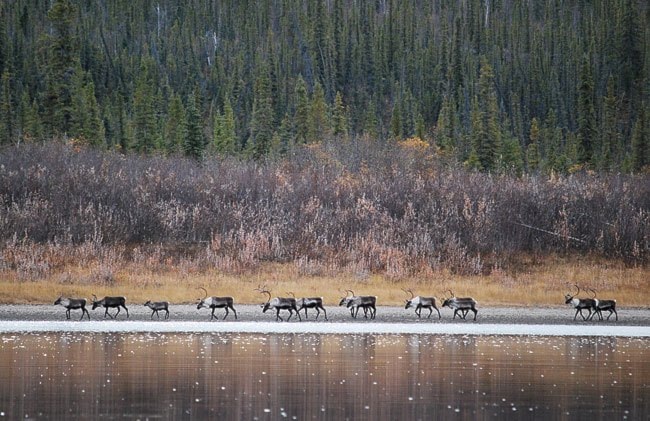The Porcupine caribou herd can tell us a lot about the presence of contaminants like mercury and radioactivity in the Yukon.
“They are our key indicator,” said Mary Gamberg, a scientist with the federal northern contaminants program. “They’re definitively our canary in the coal mine.”
Gamberg has cleared the herd of any concerns stemming from the 2011 nuclear disaster in Japan.
“Air masses can move very, very quickly and we are in the air pattern where air leaves the eastern part of Asia and comes directly up to the Yukon,” said Gamberg.
This has been proven by an airborne-mercury testing program at Little Fox Lake that has linked increased mercury levels at the lake to the increased use of coal mines in eastern Asia.
For the caribou, the concern comes from the lichen.
“We were concerned that the air mass came up, dropped radioactivity on the lichens and lichens are like sponges and they absorb stuff from the air,” said Gamberg. “They’re very effective at absorbing radioactivity. And then, of course, the caribou eat the lichens.
“That happened after Chernobyl. Reindeer herds in Scandinavia were unable to be consumed for several years because of that exact situation.”
Licensed and First Nation hunters donate skeletal muscle, like parts of the caribous’ necks, to the program each year for testing, said Gamberg.
Samples for the radioactivity search were sent to a Health Canada lab to be analyzed for the harmful elements. Those results were then compared to the archive of samples from this herd.
Samples of lichens and mushrooms were also sent for testing and those results haven’t come back just yet, Gamberg added.
There is no simple or definite reason why the Yukon, and its animals, was not affected by the fallout of Fukushima, said Gamberg. Rainstorms over the ocean may have washed the radioactivity out, or perhaps there was a change in wind.
“There are so many variables that contribute to the transport of these contaminants,” she said. “It could be any number of things.”
“But we’re good now,” Gamberg added. “This was a one-time event. If it had travelled here and gone into the lichens, it would have stayed in the lichens and we would see it in the caribou and that’s not happening, so we’re all good.”
And on a whole, the territory is looking fine when it comes to contaminants that migrate through the air and water.
The federal contaminants program has been studying traditional foods in the territory for 20 years.
“We did bears, we did willow ptarmagin, we did fish, we did cranberries, we did willow bark - everything that people take from the land,” said Gamberg. “We found that in the terrestrial system, there’s really nothing to worry about.”
Eventually, the program started to focus only on caribou, moose and some fish.
Two years ago, moose were also taken off the list because contaminant levels were so low.
Now, only Porcupine caribou and lake trout are monitored.
For fish, the lake trout are the proverbial canaries, said scientist Pat Roach.
“If they’re OK, everything else is OK,” he said.
This is because in the Yukon, lake trout live the longest, breed until they die, and are top predators.
Contaminants, like mercury, really only start accumulating in fish if they eat other fish, and if they live long enough to build up those contaminants, said Roach.
For example, salmon aren’t monitored by the program because they simply die too young. “They’re too young to be dirty,” said Roach.
Most salmon don’t tend to live past seven, whereas lake trout can live up to 100 years, he added.
The program monitors trout in Lake Laberge and Kusawa Lake.
The only First Nations that rely on lake trout are the Teslin Tlingit Council and Kluane First Nation, otherwise it’s salmon or whitefish, said Roach.
Whitefish used to be monitored - all species in 38 lakes.
“But whitefish are so clean they squeak,” said Roach. The program has stopped testing them.
There are no plans to retest any species or plants in any number of years, said Gamberg, noting that levels in the Yukon are so low that it just doesn’t seem necessary.
The only time Yukoners have to worry about contaminant poisoning is if they eat something like 42 kidneys or livers a year, said Gamberg - a moderate diet of traditional foods is completely safe.
“It always depends on how much you eat,” she said. Five kilograms of caribou meat each day may be worrisome, she said.
There is also a concern for smokers when it comes to cadmium, which naturally exists in moose and caribou. The silver-white metal exists in zinc ore and is a byproduct of zinc smelting.
But those levels are not a risk, except for some heavy smokers, said Gamberg.
“And then it’s best to limit your intake of cigarettes, rather than moose,” she said.
However, if there is another disaster like Fukushima, or if things appear to be changing, the Porcupine caribou will let us know, she added.
There are plans to continue monitoring the caribou for many years to come and archival data on the herd continues to grow, making it an even better measurement, she said.
The years of data already collected show a mercury cycle in the caribou. The cycle has never reached risk levels, but scientists like Gamberg hope this information helps them figure out why it is happening, which can lead to a much better understanding of mercury in the entire environment.
Contact Roxanne Stasyszyn at
roxannes@yukon-news.com
